Workplace silos are major drivers of miscommunication and employee disengagement. Learn how to roll out interdepartmental communications effectively to ensure a smooth information flow across your entire organization.
It’s simple: when different departments communicate effectively it leads to more informed and well-rounded business decisions.
Not to mention, effective interdepartmental communication can increase productivity by reducing duplication of effort and streamlining business operations. Of course, getting everyone on the same page is far from simple.
In this post, we’ll teach you how to ensure that interdepartmental communications are seamless and workplace silos are avoided.
Learn more about ContactMonkey’s internal communication solutions. Launch, track, measure and optimize your internal company email campaigns.
Take a self-guided tour of ContactMonkey
See how our key features can streamline your internal communications.
Take product tour

What is Interdepartmental Communication?
Interdepartmental communication is the process of sharing information, knowledge, and resources, between various departments within an organization.
There are many different types of Interdepartmental communication, including company-wide conference calls, memos, internal emails, and employee sms. But the goal behind all interdepartmental communication is to facilitate collaboration, coordination, and effective decision-making.
When interdepartmental communication is done well, it enables different departments to coordinate their efforts and work together to solve problems, streamline processes, and achieve common objectives.
Why is Interdepartmental Communication Important?
Interdepartmental communication directly impacts employee engagement, retention, and the success of an organization on all levels. Here are a few reasons why interdepartmental communication is so important.
- Facilitates Collaboration: Effective interdepartmental communication fosters collaboration between different departments, allowing them to work together towards shared objectives. This collaboration can lead to more efficient processes and better decision-making.
- Improves Efficiencies: When departments collaborate effectively, it helps to avoid duplication of efforts, and tasks can be completed more efficiently. This can lead to increased productivity and better use of resources.
- Supports Innovation: Great interdepartmental communication can lead to the exchange of ideas of the sort that spark innovation within an organization. Different departments can bring unique perspectives and insights that can help to create new solutions and approaches to problems.
- Improves Customer Service: When departments communicate effectively, it helps to ensure that customers get accurate and timely information. This can lead to improved customer satisfaction and retention.
- Reduces Conflict: Miscommunication and misunderstandings between departments can lead to conflict and tension within an organization. Effective interdepartmental communication can help to prevent conflicts and resolve them quickly when they do arise.
Modern internal comms and measurement tools
No design or technical expertise needed. Save time, increase engagement, and dazzle your employees with fun and interactive communications.
Explore all features

Benefits of Interdepartmental Communication
Interdepartmental communication is critical for the smooth operation of an organization, and it plays a vital role in ensuring that everyone is working towards the same goals and objectives. Let’s take a closer look at a few of the benefits of effective interdepartmental communication:
- Improved Relationships: Effective communication between departments helps to build trust and foster positive relationships. When departments feel that they can rely on each other for accurate information and support, it can lead to stronger working bonds. For example, you can create welcome aboard email templates and send out new employee introduction emails to help everyone acquaint themselves with new team members.
- Improves Understanding: Departments may have different goals, priorities, and perspectives. Effective communication can help to ensure that everyone understands each other’s needs and challenges, which leads to more empathy and cooperation.
- Increased Efficiency and Effectiveness: When done well, interdepartmental communication avoids duplication of efforts and ensures that everyone is working towards the same goals.
- Improves Coordination: Effective communication between departments can help to ensure that everyone is on the same page when it comes to timelines, milestones, and deliverables. This can improve coordination and help to keep projects on track.
- Increases Access to Resources: Interdepartmental communication can help to ensure that departments have access to the resources they need to complete their work.
- Improved Problem Solving: When departments collaborate effectively, new insights and perspectives flow easily. This can play a critical role in improving problem-solving.
- Brings Diverse Perspectives: Effective communication between departments brings together individuals with different skills, experiences, and knowledge. This diversity of perspectives can lead to more creative and effective solutions to complex problems.
- Promotes Brainstorming: Interdepartmental communication can facilitate brainstorming sessions where individuals from different departments can come together to generate new ideas and approaches for solving a variety of organizational issues.
- Enhanced Teamwork: Interdepartmental communication promotes collaboration and cooperation between departments. When teams work together towards common goals, it can create a sense of shared purpose and help to break down silos.
Challenges of Interdepartmental Communication
Just as effective interdepartmental communication offers a handful of benefits, poor interdepartmental communication brings a slew of challenges. Here are a few to keep in mind:
- Poorly Planned Meetings or Lack of Meetings: we’ve all been there before—a broken Zoom link, an invite sent to the wrong email list. Poorly coordinated meetings in any situation lead to frustration and employee disengagement across departments.
- Language and Jargon: Departments may use different terminology or jargon, making it difficult for others to understand what they are talking about. The result: miscommunication and employee disengagement.
- Different Priorities: Departments may have different goals and priorities, leading to conflicting views on how to approach a particular issue. When handled improperly, this can lead to full-scale conflicts.
- Silo Mentality: Departments may become too focused on their own work, leading to a lack of communication and collaboration with other departments. This usually happens as a result of poorly coordinated interdepartmental communications.
- Unclear Expectations or Objectives: When one department doesn’t know what the other is working on, it quickly leads to unclear expectations and disjointed goals.
To avoid the repercussions of poorly planned communications, use an all-in-one internal email software to synchronize and streamline interdepartmental messages. ContactMonkey’s communications tool combines email template design, automation, email tracking, and event management into a single high-powered employee communications software. See how it works for yourself.
Watch ContactMonkey LIVE in action
Join live demo
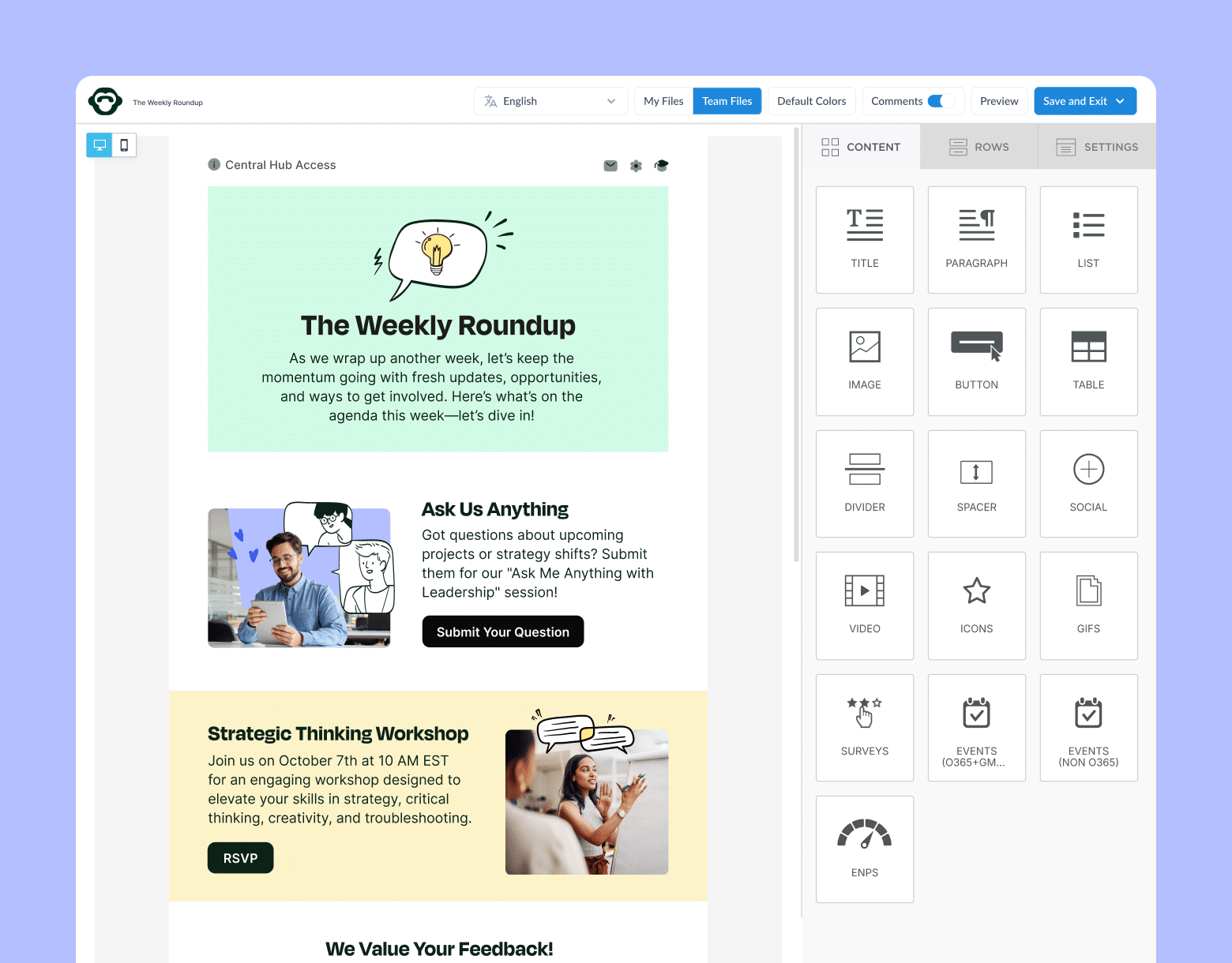
Strategies for Improving Interdepartmental Communications
If you’re not sure where to start when it comes to improving interdepartmental communications, consider these strategies to get your feet off the ground:
Establishing Clear Goals and Objectives: Setting clear goals and priorities for the organization can help to ensure that everyone is working towards shared objectives. This can help reduce conflicts and improve coordination between departments. Remind employees of quarterly and yearly goals during your monthly town hall as well as through bi-weekly internal newsletters.
Developing a Strategy for Effective Meetings: Building relationships between departments can help to increase trust and collaboration. This can be achieved through social events, employee appreciation day activities, virtual team-building exercises, and cross-functional employee training.
Creating an Open Dialogue Among Departments: Foster a culture of collaboration and teamwork, where departments feel comfortable sharing information and working together towards common goals. Encourage cross-functional teams to work on projects together and use ContactMonkey’s email collaboration software features to let different departments share insights and ideas across internal messages.
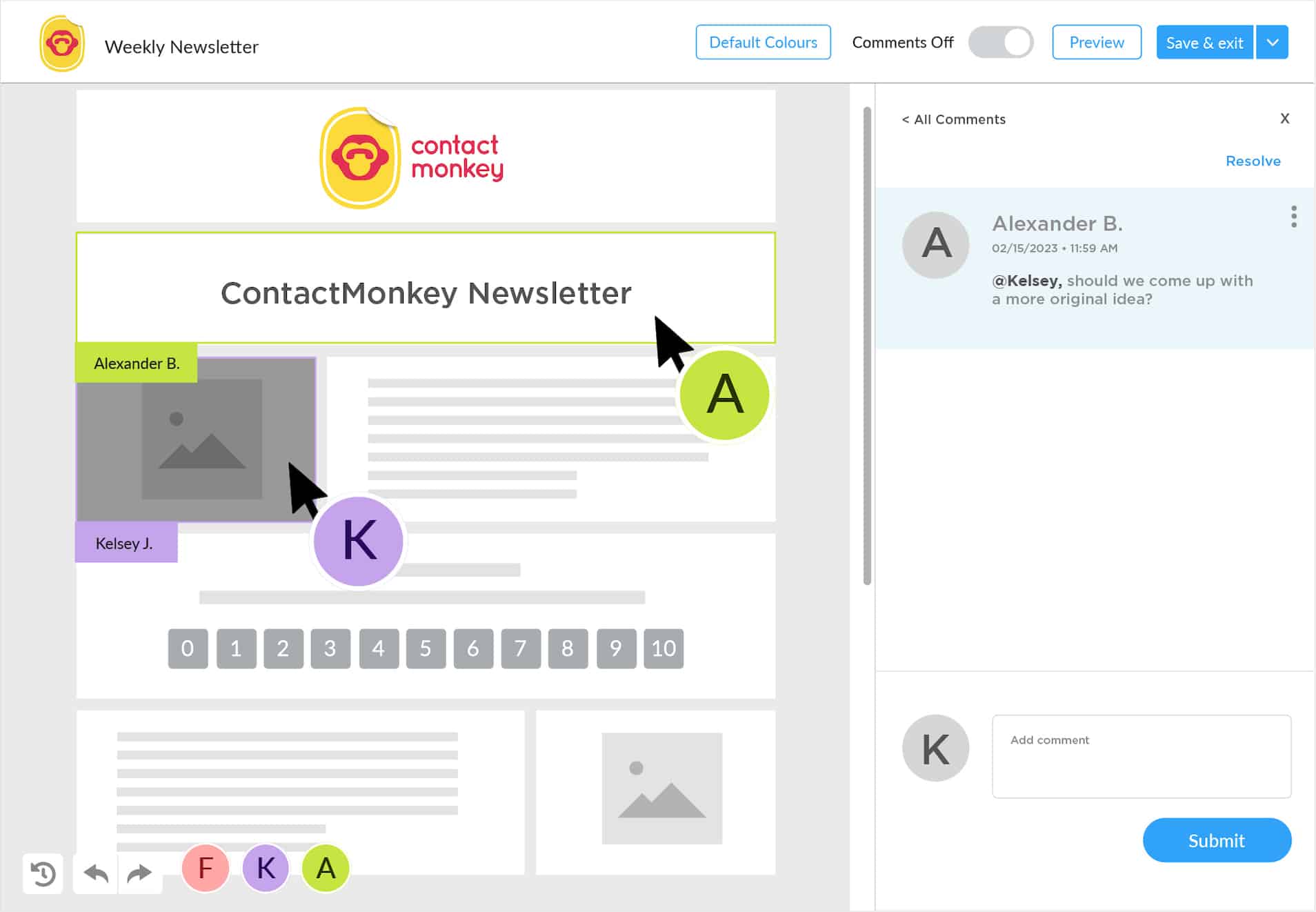
Technology Solutions to Improve Interdepartmental Communications
Implementing new communications technology is a powerful investment towards facilitating open and continuous communication between departments. But choosing the right software is no small feat. Below, we break down the top tools available on the market today and weigh their advantages.
1. All-in-one internal communications software
Using an all-in-one internal communications software for interdepartmental communications offers the benefit of a centralized communication system for all of your messaging. All-in-one communications tools offer a combination of features, which usually include email template design tools, automation, internal analytics, and email scheduling.
With ContactMonkey, you get access to all of these features alongside employee SMS, event management, email pulse surveys, and a handful of integrations.
This type of software speeds up interdepartmental communications and makes it easy to track and organize conversations, files, and tasks from a single place.
Learn more about how you can benefit from using internal collaboration software.
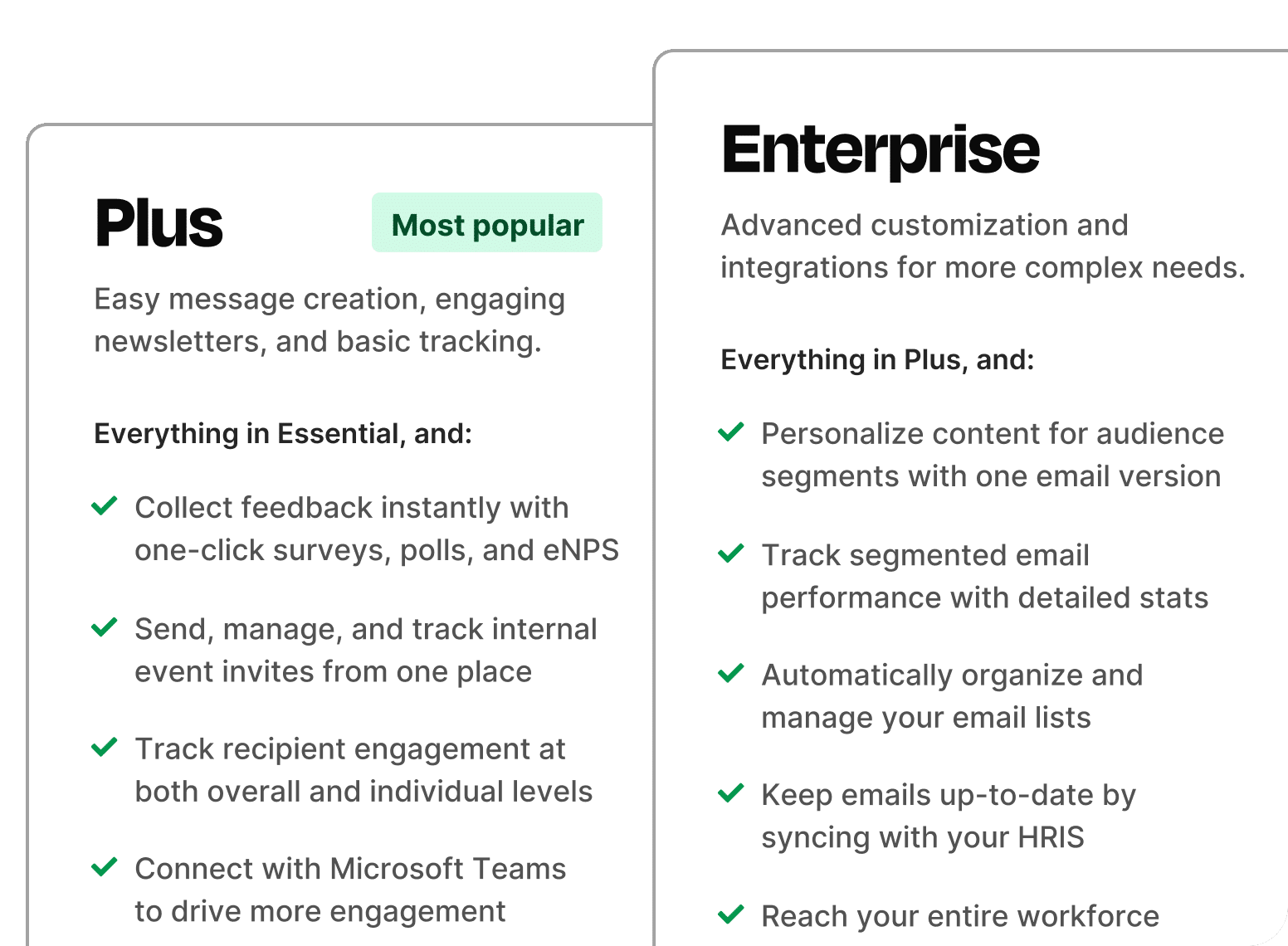
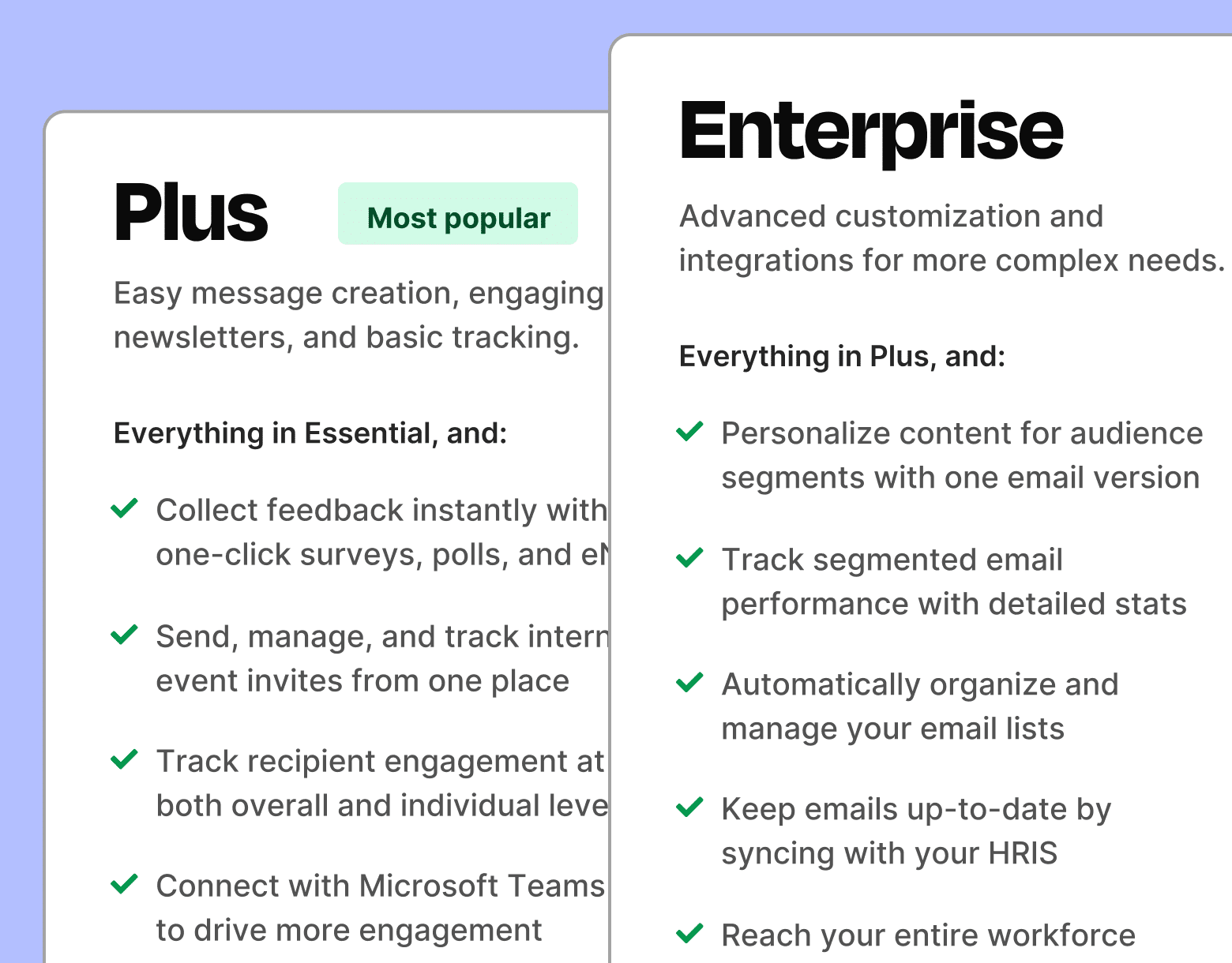
2. HTML Email templates
Using HTML email templates for interdepartmental communications offers a consistent and professional format for key messages. Gmail and Outlook email templates improve the look and feel of your emails, which ultimately encourage employees to read them.
More than that, a consistent look and feel across your communications creates a more enjoyable reader experience. Not to mention, creating email templates makes it easy to uphold employer branding for more cohesive messaging across your internal company newsletters.
If you’re using templates with an email segmentation tool like ContactMonkey you’ll also be able to create customized messages for different employee groups and departments. By keeping the design simple and including branding, sections, links, and responsive design principles, you can create a template that is both striking and easy to use.
3. Virtual conferencing platforms
Virtual conferencing platforms provide a convenient and efficient way for interdepartmental communication in a remote work environment. But not all virtual conferencing platforms are made the same.
You’re probably already familiar with Zoom. But there are dozens of other internal meeting tools to choose from and some may be better at meeting your needs than others. Here are a few video conferencing platforms worth checking out:
4. Employee SMS tool
Employee SMS is the best option when it comes to quick, asynchronous communication with employees. It’s especially useful when it comes to engaging frontline workers. That’s because SMS enables speedy, real-time, personalized messaging.
In fact, 90% of texts are opened within five minutes, which makes SMS a faster, more reliable way for employees to stay up-to-date with the latest alerts.
Some communications tools even offer the option of using email and sms together, letting you get the best of both and optimize interdepartmental messages by synchronizing all of your communication channels.
Create internal emails that get opened and read
No design or technical expertise needed. Save time, increase engagement, and dazzle your employees with fun and interactive communications.
Explore email features

5. Intranet
Intranet communications are a great way to share interdepartmental resources as they provide a central platform for employees to access information, communicate with each other, and collaborate on projects. Intranets can serve as a repository of organizational knowledge, making it easier for employees to find information they need across different departments.
In addition, employee intranets can facilitate project management by providing tools for task assignment, progress tracking, and collaboration between team members. For optimal engagement, you can use your company newsletters to remind employees to check the intranet and drive added engagement.
6. Employee app
Employee apps are a popular and effective way to improve interdepartmental communications, particularly for organizations with a large and distributed workforce. Employee apps allow for real-time communication through messaging and chat features, making it easier for employees from different departments to communicate with each other and collaborate on projects.
Typically, employee communication apps are accessible on mobile devices, allowing employees to stay connected and informed even when they are away from their desks. Managers and employees alike can quickly share important information such as company news, policies, and procedures across different departments.
7. Pulse surveys
Pulse surveys are a type of employee survey that can be used to gather quick and frequent feedback from employees across different departments. Pulse surveys typically consist of a small number of questions, which can be administered on a regular basis (e.g., weekly, bi-weekly, or monthly).
Pulse surveys can be used to gauge employee engagement and satisfaction across the company, allowing employers to pinpoint which departments might be falling behind when it comes to engagement. By measuring employee engagement regularly, organizations can identify trends and take action to improve communication and engagement.
8. Employee social media
Employee social media can be an effective tool for improving interdepartmental communications by creating a social network where employees can share and learn about each other beyond their work roles.
These platforms enable employees to connect with colleagues in departments they might not ordinarily engage with. In turn, employees from different areas of the company can build relationships that foster collaboration and knowledge-sharing across departments.
9. Internal podcast
Internal podcasts can be a powerful tool for interdepartmental communications because they provide a simple, entertaining, and passive way for all employees to listen to workplace updates at their convenience.
Employees can listen during their commute, while exercising, or even while doing work that doesn’t require their full attention. This makes it easy for staff across all departments to get on the same page and helps nurture a fun and inclusive workplace culture.
Start two-way conversations and employee feedback loops
Learn how to engage staff with pulse surveys, content ratings and reactions, custom polls, and more. Ready to send modern emails?
See engagement features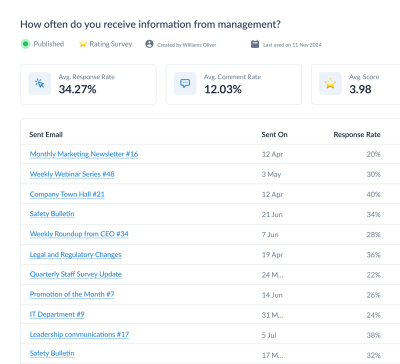
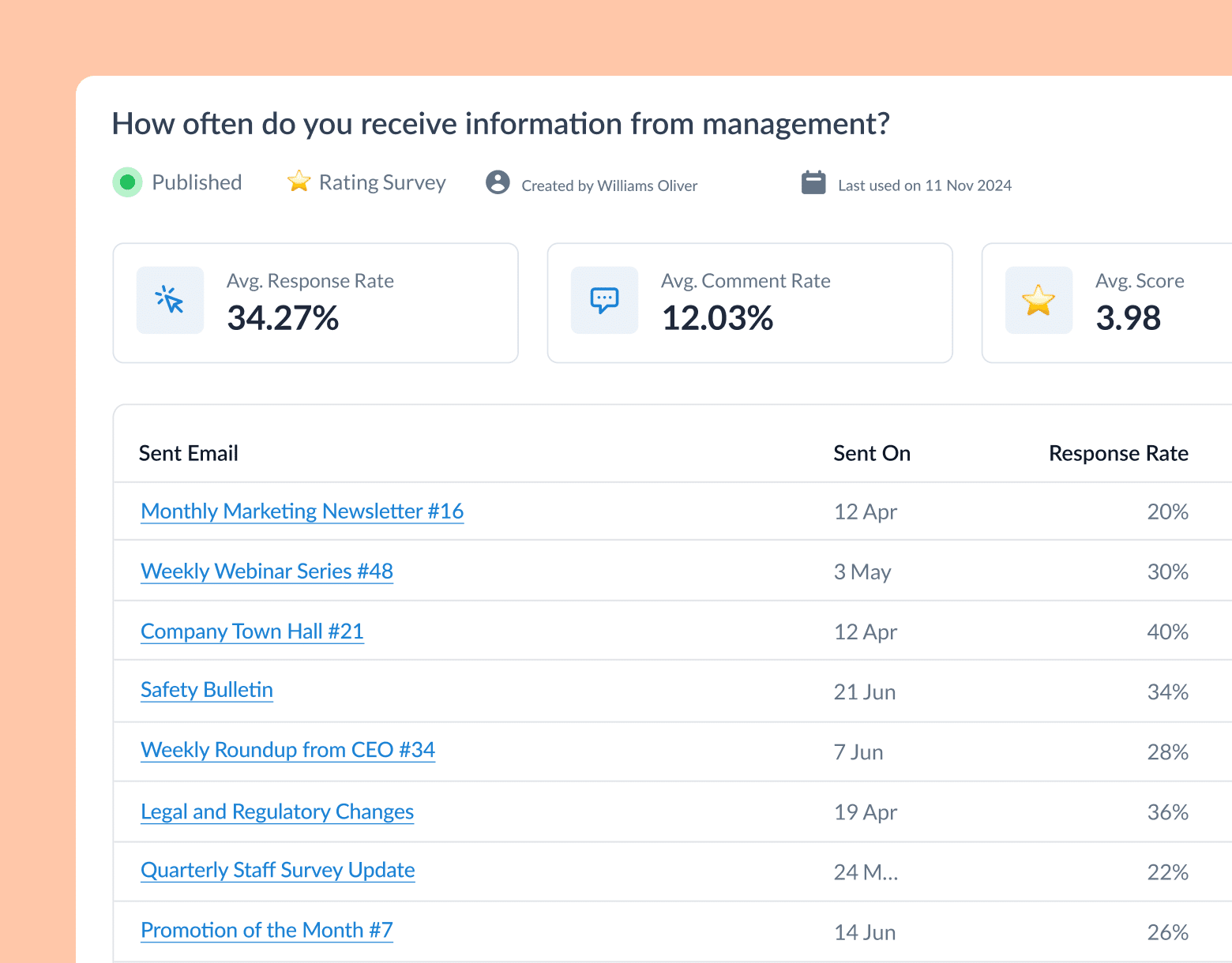
10. Email analytics software
Email analytics software is essential when it comes to tracking and analyzing the effectiveness of interdepartmental communications. With a segmented email tracking tool you can see how many employees are opening and engaging with internal emails from each department.
[image of analytics dashboard]
In turn, you can use this information to determine which types of content are most effective at capturing the attention of employees from different teams. From there, you can customize your communications accordingly and ensure that employees are receiving the most relevant and useful information.
Streamline Interdepartmental Communication With ContactMonkey
Effective interdepartmental communication leads to better collaboration and teamwork, more efficient decision-making and improved problem-solving. If you’re looking to reap the benefits of seamless interdepartmental communication, it’s time to implement the right software.
ContactMonkey’s all-in-one internal communications tool allows you to create, send, and track segmented interdepartmental emails directly from Outlook and Gmail. You’ll be able to automatically collect email statistics and employee feedback to create tailored messaging and deliver the right information to the right people.
Want to see ContactMonkey’s email tracking tools in action? Book a free demo to see exactly how email metrics can help you send better content and boost employee engagement.



